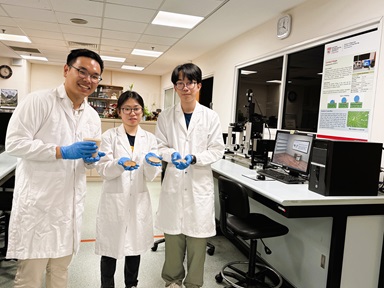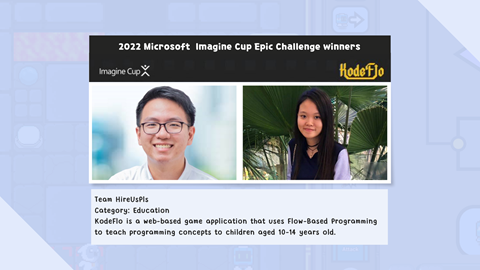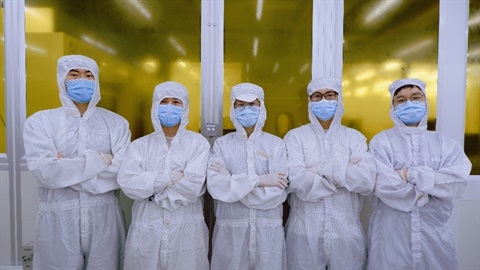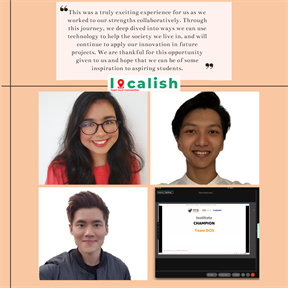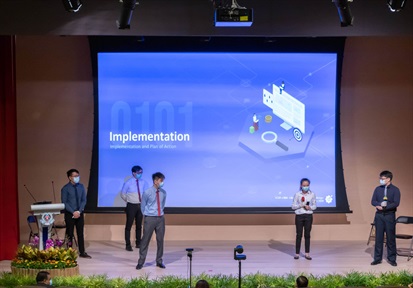Mecatron Rises from Spare Parts to Champion Autonomous Subsea
A first place win for the student robotic's team comes just two years into reignited efforts.
NTU undergrad Jennifer Goh didn’t necessarily set out to help run an internationally competitive autonomous subsea robot team when she joined student-run robotics group Mecatron in 2023. She was simply drawn to the project due to her marine biology background.
However, within two short years, Goh found herself a core member of the group that was celebrating first place in the 2025 Singapore Autonomous Underwater Vehicle Challenge (SAUVC).
It was a win for the underdog. NTU’s student-led team had barely been around long enough to establish a track record, yet they clinched first place against 67 entries from over 20 countries.

Mecatron team celebrates first place win
Seeing the Potential
“Mecatron’s roots come from a previous team that existed long ago, but that team didn’t last and ended up disbanding,” explained Goh. “What they did leave behind was a bunch of spare parts and a few individuals, including Mechanical and Aerospace Engineering (MAE) undergrad and previous CEO of the team Vu Tien Luc, who wanted to revive the effort enough to create a team from scratch.”
The team essentially started with an open call, saying "Who’s interested in marine robotics?" and gradually recruited members. Soon Goh, a College of Science student, was surrounded by engineering students. They didn't know each other well initially, but the competition and shared goal would eventually bring them together.
“We each do our own thing, but we meet up quite often,” Goh described of Mecatron’s working style. Core members meet weekly while the larger team meets biweekly in the Dyson-NTU Studio, a collaborative engineering space established in partnership with the James Dyson Foundation back in 2018.
The meetings happen at night to accommodate as many schedules as possible, as many students are absorbed in classes and internships. During this time, members exchange information and keep each other updated on the progress of each sector: hardware, software, web development and administration or outreach.
"We want to ensure that anybody should be able to talk about the bot, not just people who work on hardware can only talk about hardware, for example,” Goh said of the knowledge sharing. Her job is to help with business development and marketing while ensuring the team's work is optimised for real-world applications.
This time around, that bot is an autonomous underwater inspection vehicle named Lucy. Lucy is pink, equipped with an underwater camera, and optimised for manoeuvrability.
From Kevin to Lucy
Last year was the first year Mecatron engaged in competition, entering Lucy’s predecessor Kevin in the Singapore AUV Challenge where the team scored third place.

Lucy and Kevin, side by side
“One thing that we took away from our experience competing with Kevin is a refinement of strategy,” offered Mecatron hardware specialist turned CEO Zach Low who attended both competitions.
“With Kevin we tried to do everything, but we realised that actually we should focus on things that we can actually achieve and those specific few tasks really well,” he added.
Hence, Lucy is a smaller and nimbler than Kevin. The pink bot is more aerodynamic and can perform flips. However, it’s design doesn’t come with the robot arm of its predecessor, eliminating some functionalities and features.
“Specialisation was key to our success,” said Low. “Other improvements included a more streamlined software stack.”
But even after deciding on a specialization and cleaning up the code, a lot of getting Lucy to first place was trial and error.

Lucy and Kevin at the Dyson-NTU Studio
“During the challenge, we are required to actually communicate with the vehicle when it is already underwater as the sequence of tasks required is not communicated prior to the competition,” stated software specialist Wei Ming Wong. “Underwater communication is not easy as there is a lot of noise that distorts signals.”
The team first tried offering QR codes to Lucy’s camera, which didn’t work as well as planned. They next tried communicating acoustically through sonar.
“The acoustic method is working, but it's not as reliable as we'd hoped. It’s about a 50 percent success rate,” detailed Wong.
Eyes Ahead
The team hopes to improve on this before their next competition in August at RoboSub in California. That competition will see a return to using Kevin. Lucy will stay at home.
“RoboSub is meaningful because it's one of the biggest autonomous underwater vehicle events. It’s really a huge milestone to achieve as a team that wants to commit to marine robotics and autonomous robotics,” shared Goh.
Getting Kevin prepped for RoboSub does have some challenges, the team noted. For one, it takes place at the end of summer. The lead up to the competition includes a period when many of the crew have just finished exams and are off on travel. Others are completing summer internships.
“Time is one of our biggest challenges as we prepare for RoboSub,” commented Vu. “This is our first time attempting all tasks and ensuring that our algorithms are robust and reliable.”
Low explained the answer is to prepare early to complete as much testing as possible before arriving in California.
“You don’t want to find yourself in the odd position of the competition serving as a test,” he chuckled. “We’d like for Kevin to arrive in the USA resembling an official commercial product- ready and reliable.”
Goh also has commercialisation on her mind. She’s seen some similar teams spin startups out of their tech. She admits that the competitions create visibility and good networking opportunities with industry.
“When it comes to both our team and our product, we want to create something that lasts,” she beamed.


